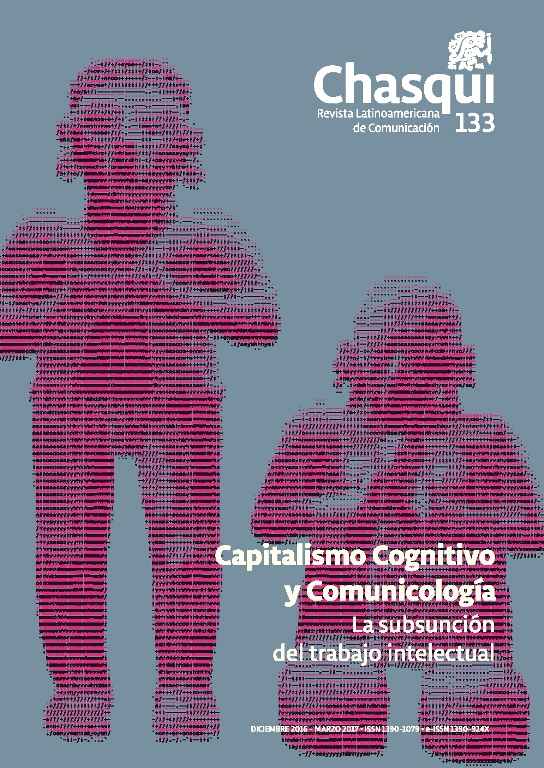Interaction experiences of brazilian women with counterintuitive advertising played by black women
DOI:
https://doi.org/10.16921/chasqui.v0i133.2743Keywords:
advertising, grounded theory, mediatization, racismAbstract
This research presents an explanation proposal about the meaning links that are produced when there is interaction between Brazilian women and counterintuitive advertising narratives, which show black women as protagonists of their discourses. It is a qualitative investigation oriented by the theoretical interconnection of perspectives of Symbolic Interactionism and Reception Studies (Mediatization, Mediations, and Interaction), focused on influences of the media in the (re)elaboration of social identities, as basilar theoretical referential, and through the Constructivist Grounded Theory, as a methodological approach.References
Baldin, N. & Munhoz, E.M.B. (2011). Snowball (bola de neve): uma técnica metodológica para pesquisa em educação ambiental comunitária. In X Congresso Nacional de Educação - Educere. Curitiba.
Batista, L.L. & Costa, M.A.R. (2011). O racismo subentendido: a comunicação “politicamente correta” e seus efeitos em estereótipos e preconceitos. En Batista, L.L. & Leite, F. (org.). O negro nos espaços publicitários brasileiros: perspectivas contemporâneas em diálogo. São Paulo: ECA/USP: CONE.
Bauer, T. (2010). Media Literacy. Entrevista com Thomas A. Bauer. CoMtempo. Revista Eletrônica do Programa de Pós-graduação da Faculdade Cásper Líbero. Volume (2)2, pp. 1-5.
Bianchi, E.M.P.G. & Ikeda, A.A. (2008). Usos e aplicações da Grounded Theory em administração. Gestao.org. Revista Eletrônica de Gestão Organizacional, Universidade Federal de Pernambuco, (6)2, pp. 231-248.
Blair, V. I. & Banaji, M. R. (1996). Automatic controlled processes in stereotyping priming. Journal of Personality and Social Psychology, (70)6, pp. 1142-1163.
Blair, V.I. & Lenton, A.P. (2001). Imagining stereotypes away: the Moderation of implicit stereotypes through mental imagery. Journal of Personality and Social Psychology, (81)5, pp. 828–841.
Blumer, H. (1980). A natureza do interacionismo simbólico. En: Mortensen, C D. Teoria da comunicação: textos básicos. São Paulo: Mosaico (119-138).
Blumer, H. (1986 [1969]). Symbolic interactionism: Perspective and method. Berkeley, CA. University of California Press.
Boyer, P. (2001). Religion explained: the evolutionary origins of religious thought. New York: Basic Books.
Braga, J.L. (2006). A sociedade enfrenta sua mídia. Dispositivos sociais de crítica midiática. São Paulo: Paulus.
Braga, J.L. (2008). Comunicação, disciplina indiciária. Matrizes, São Paulo, (1)2, pp. 73-88.
Braga, J.L. (2012). Uma teoria tentativa. Revista da Associação Nacional dos Programas de Pós-Graduação em Comunicação | E-compós, Brasília, (15)3.
Braga, J.L. (2015). Lógicas da mídia, lógicas da midiatização? En Fausto Neto, A. [et.al.]. Relatos de investigaciones sobre mediatizaciones. Rosario: UNR Editora.
IBGE [Instituto Brasileiro de Geografia e Estatística]. (2010). Censo nacional. Recuperado de http://bit.ly/1G0W9oi.
Charmaz, K. (2009). A construção da teoria fundamentada: guia prático para análise qualitativa. POA: Artmed.
Dasgupta, N. & Greenwald, A.G. (2001). On the malleability of automatic attitudes: combating automatic prejudice with images of admired and disliked individuals. Journal of Personality and Social Psychology, (81)5, pp. 800-814.
Di Nallo, E. (1999). Meeting points. Soluções de Marketing para uma sociedade complexa. SP: Edições Cobra.
Elias, N. (1978). What is Sociology? London: Hutchinson.
França, V.V. (2007). Contribuições de G.H. Mead para pensar a comunicação. En Anais do XVI Encontro Anual da Compós. Curitiba: UTP.
França, V.V. (2008). Interações Comunicativas: a matriz conceitual de G.H. Mead. En Primo, A. et. al. Comunicação e Interações. Livro da Compós. Porto Alegre: Sulina.
Fry, P. (2002). Estética e política: relações entre “raça”, publicidade e produção da beleza no Brasil. In Goldenberg, M. Nu & Vestido: dez antropólogos revelam a cultura do corpo carioca. Rio de Janeiro: Record.
Glaser, B. & Strauss, A. (1967). The discovery of Grounded Theory: strategies for qualitative research. Chicago, Nova York: Aldine de Gruyter.
Hepp, A. (2012). Mediatization and the ‘molding force’ of the media. Communications. (37)1, pp. 1-28.
Hepp, A. (2014). As configurações comunicativas de mundos midiatizados: pesquisa da midiatização na era da “mediação de tudo”. Matrizes. (8)1, pp. 45-64.
Hepp, A. & Krotz, F. (2014). Mediatized worlds: understanding everyday mediatization. En Hepp & Krotz (eds.) Mediatized worlds: culture and society in a media age. London: Palgrave. pp. 1-15.
Hepp, A. & Hasebrink, U. (2013). Human interaction and communicative figurations. The transformation of mediatized cultures and societies. Communicative Figurations. Working Paper, n. 2.
Hutchinson, S. (1998). Education and Grounded Theory. En: Sherman, Robert R. & Webb, R. D. Qualitative research in education: focus and method. Londres: Falmer Press. pp. 123-140.
Krüger, H. (2004). Cognição, estereótipos e preconceitos sociais. En Lima, M.E.O. Estereótipos, preconceitos e discriminação: perspectivas teóricas e metodológicas. Salvador: EDUFBA.
Krotz, F. (2014). Media, Mediatization and Mediatized Worlds: a discussion of the basic concepts. En Hepp & Krotz (Eds.) Mediatized worlds: Culture and society in a media age. London: Palgrave. pp. 72-87.
Leite, F. (2014). Publicidade contraintuitiva: inovação no uso de estereótipos na comunicação. Curitiba: Editora Appris.
Leite, F. (2009). A propaganda contraintuitiva e seus efeitos em crenças e estereótipos. Dissertação de mestrado. Departamento de Relações Públicas, Propaganda e Turismo da Escola de Comunicações e Artes, Universidade de São Paulo: São Paulo.
Luckmann, B. (1970). The small life-worlds of modern man. Social Research, (37)4, pp. 580-596.
Martín-Barbero, J. (1987). De los medios a las mediaciones. Barcelona: Gustavo Gili.
Mead, G.H. (1982 [1934]). Espiritu, persona y sociedad: desde el punto de vista del condutismo social. Barcelona: Paidos.
Piedras, E.R. (2009). Fluxos publicitários: anúncios, produtores e receptores. Porto Alegre: Sulinas.
Downloads
Published
Issue
Section
License
- Authors retain copyright and grant the journal right of first publication with the work simultaneously licensed under a Creative Commons Attribution-NoDerivs License (CC BY-ND) that allows others to share the work with an acknowledgement of the work's authorship and initial publication in this journal.
- Authors are able to enter into separate, additional contractual arrangements for the non-exclusive distribution of the journal's published version of the work (e.g., post it to an institutional repository or publish it in a book), with an acknowledgement of its initial publication in this journal.
- Authors are permitted and encouraged to post their work online.

